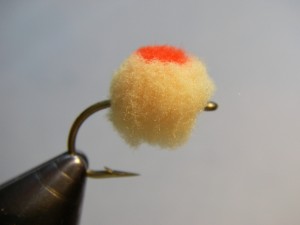 The typical material for tying Glo Bugs is Glo Bug Yarn or Egg Yarn and many, including myself have found tying nice, round looking egg flies is difficult when using this material. In the mid-1990’s a new material, McFly Foam yarn, hit the market and tying nice, round eggs has been easier ever since. It’s available in huge array of colors and anglers can mix them up or incorporate dots very easily for a custom combination.
The typical material for tying Glo Bugs is Glo Bug Yarn or Egg Yarn and many, including myself have found tying nice, round looking egg flies is difficult when using this material. In the mid-1990’s a new material, McFly Foam yarn, hit the market and tying nice, round eggs has been easier ever since. It’s available in huge array of colors and anglers can mix them up or incorporate dots very easily for a custom combination.
An advantage to tying these flies is most of the material sits above the hook shank without impeding the hook gape allowing you to use a little smaller hook while keeping the egg the focal point hiding the hook.
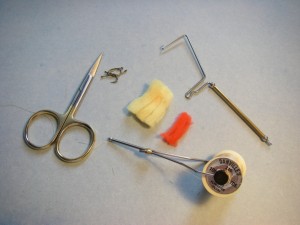
The primary reason why McFly material works so well is its amount of elasticity. The texture, however, is very “clingy” so if you have dry hands, dead skin and/or rough edges on your fingers you are about to learn the meaning of frustration. Try using a pumice stone to smooth those fingertips and you’ll find it’s easier to handle this material – especially when tying a couple dozen McFly Foam eggs.
There is pretty much every color variation available in McFly Foam to match the egg pattern you desire. Try mixing a few similar colors to achieve a mottled, but realistic egg imitation to accommodate the classic primary color with a dot.
McFly Foam Egg Recipe
Hook: TMC 105 #6-10, TMC 2457 #8-12 (Scud Hook) or Gamakatsu C14S
Thread: Danville Flymaster Plus – color to match main yarn color
Yarn: McFly Foam – Oregon Cheese and Dark Red
Tying Instructions
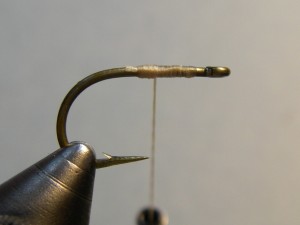 Step 1. Insert hook into vise and make a thread wrap working from the hook eye
Step 1. Insert hook into vise and make a thread wrap working from the hook eye
back to the hook point and the midway between the hook point and the hook eye.
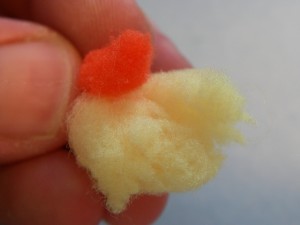 Step 2. Cut egg yarn about 1 ½ inches long. The primary color should be a little less than the diameter
Step 2. Cut egg yarn about 1 ½ inches long. The primary color should be a little less than the diameter
of a hot dog. If you don’t use enough yarn the fly won’t be as round as it should be. Use too
much and it will look a bit obtuse. The second color should be a little less than the diameter of a pencil.
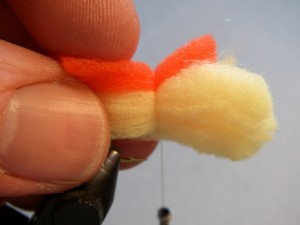 Step 3. Lay the McFly Foam parallel on top of the hook with the secondary color on top and
Step 3. Lay the McFly Foam parallel on top of the hook with the secondary color on top and
wrap down with a few loose wraps midway on the yarn. Tighten the wraps and pull firmly with a
few more wraps being sure to wrap on top of one another. This is why we use a strong, flat thread.
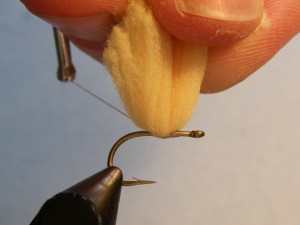 Step 4. Pull the yarn upward and horizontally wrap the base of the yarn like
Step 4. Pull the yarn upward and horizontally wrap the base of the yarn like
you would a post on a parachute dry fly. Make about 4 or five, tight wraps.
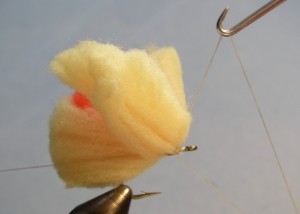 Step 5. Advance the thread to just in front of the yarn and whip finish.
Step 5. Advance the thread to just in front of the yarn and whip finish.
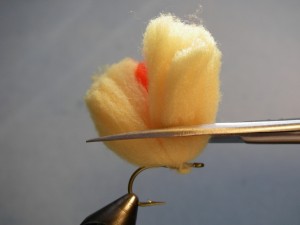 Step 6. Trim the excess foam by pulling up on the yarn (not pictured) and then cut. This step
Step 6. Trim the excess foam by pulling up on the yarn (not pictured) and then cut. This step
is crucial to the appearance of the fly and with a little experience you should be able to determine
the proper length. Try cutting the foam no more than half of the distance of the hook gape.
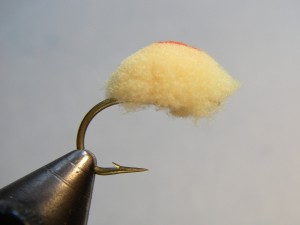 Step 7. After cutting, the foam looks domed not round. Take your
Step 7. After cutting, the foam looks domed not round. Take your
fingers and roll the material which will give you a rounded appearance.
 Step 8. Your finished McFly Foam egg.
Step 8. Your finished McFly Foam egg.
